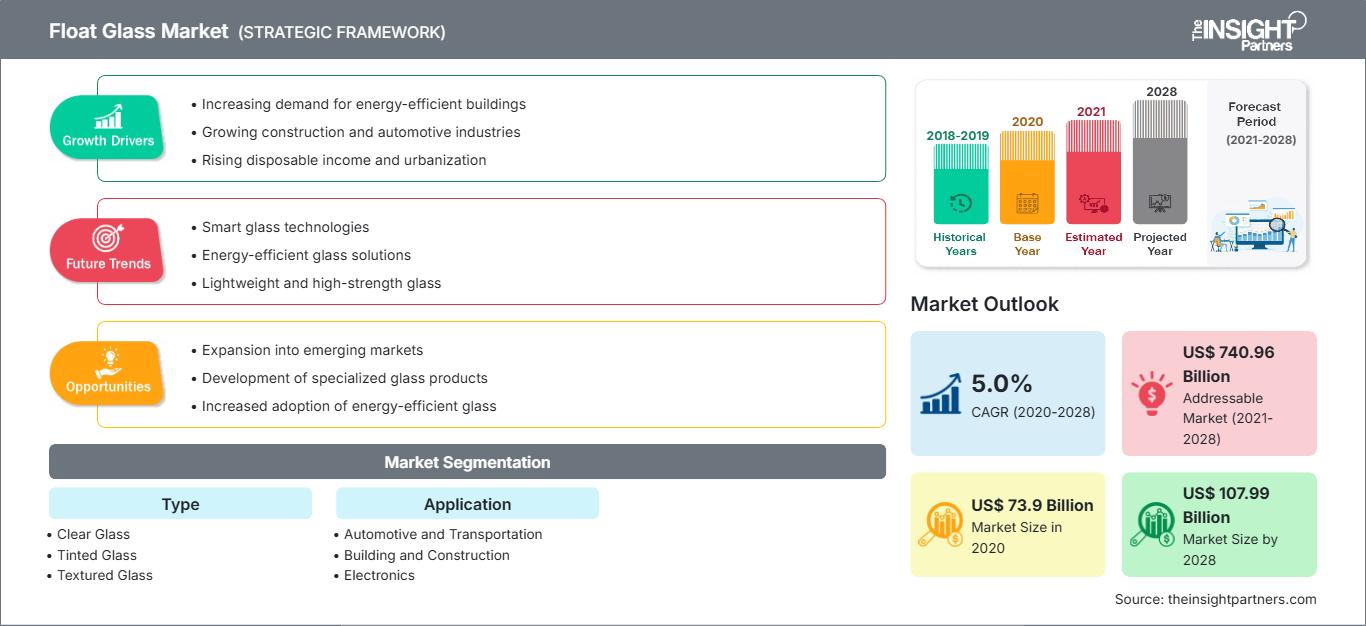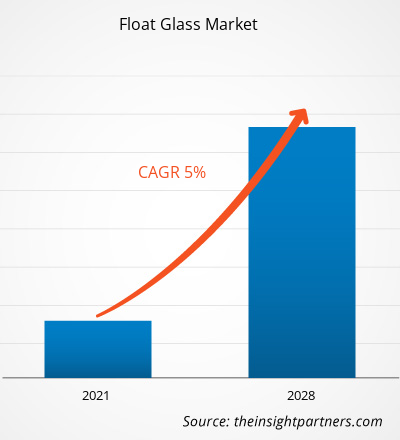El mercado del vidrio flotado se valoró en 73.897,83 millones de dólares estadounidenses en 2020 y se prevé que alcance los 107.991,35 millones de dólares estadounidenses en 2028; se espera que crezca a una tasa de crecimiento anual compuesta (TCAC) del 5,0% entre 2021 y 2028.
El vidrio flotado es un vidrio extremadamente liso y sin distorsiones que se utiliza en diversas industrias, como la construcción, la automoción, la electrónica y la energía solar, entre otras. Su fabricación consiste básicamente en verter vidrio fundido del horno en una cámara que contiene un lecho de estaño fundido. El aumento del uso del vidrio flotado en el diseño de interiores y la arquitectura moderna ha contribuido significativamente al incremento de su demanda, y se emplea en otras aplicaciones de la construcción, como techos, suelos, vidrios reflectantes, revestidos, ventanas, espejos, tableros de mesa y vidrio aislante. Además, se prevé que el creciente uso del vidrio flotado en la automoción impulse el sector durante el periodo de previsión.
En 2020, Asia Pacífico representó la mayor cuota del mercado mundial de vidrio flotado. El creciente desarrollo de los sectores automotriz y de la construcción impulsa la demanda de vidrio flotado en la región. El extenso sector automotriz consolidado en países como China e India también incrementa la demanda de vidrio flotado en estos países. Asimismo, el desarrollo y la creciente penetración de la industria solar en Asia Pacífico impulsan el crecimiento del mercado de vidrio flotado en la región.
Obtendrá personalización gratuita de cualquier informe, incluyendo partes de este informe, análisis a nivel de país y paquetes de datos de Excel. Además, podrá aprovechar excelentes ofertas y descuentos para empresas emergentes y universidades.
Mercado del vidrio flotado: Perspectivas estratégicas

- Obtenga las principales tendencias clave del mercado que se describen en este informe.Esta muestra GRATUITA incluirá análisis de datos, que abarcarán desde tendencias de mercado hasta estimaciones y pronósticos.
El cierre de diversas plantas y fábricas en Norteamérica, Europa, Asia Pacífico, Sudamérica, Oriente Medio y África debido a la pandemia de COVID-19 ha obstaculizado la cadena de suministro global, los procesos de fabricación, los plazos de entrega y las ventas de productos. Además, las restricciones impuestas por países de Europa, Asia y Norteamérica están afectando la colaboración empresarial y las oportunidades de asociación. La pandemia de COVID-19 ha tenido un impacto significativo en el mercado del vidrio flotado. Las interrupciones en la producción y la cadena de suministro han tenido un impacto negativo en este mercado. Se prevé que la escasez de vidrio se prolongue hasta 2021, causando trastornos en diversos sectores. El suministro de vidrio se está reduciendo y su compra se ha encarecido debido a varios factores, como la pandemia mundial y los aranceles internacionales. Como consecuencia de la pandemia, muchas fábricas y fabricantes se han visto obligados a suspender o ralentizar la producción de vidrio, lo que dificulta enormemente satisfacer la demanda actual. Reactivar las fábricas tras un cierre o una producción reducida durante un período prolongado puede resultar excepcionalmente difícil, sobre todo si las empresas no operan a plena capacidad debido a las normas de salud y seguridad. Además, dado que la vacunación contra la COVID-19 es una prioridad tanto para el público como para el sector sanitario, la disponibilidad de vidrio se ha redirigido a este fin, lo que ha provocado la falta de disponibilidad de vidrio para otras industrias, creando así escasez de vidrio en el mercado.
Perspectivas del mercado
Aumento de la demanda por parte del sector de la construcción
El vidrio flotado se fabrica mediante un proceso de fusión en el que vidrio reciclado, cal, arena de sílice, potasa y sosa se funden en un horno y se vierten sobre un lecho de estaño fundido. Su uso está en auge en la industria de la construcción, incluyendo los sectores residencial, comercial e industrial. El vidrio flotado se caracteriza por su alta transmisión de luz, la posibilidad de producir una amplia gama de colores y opacidades, y su buena inercia química, lo que ha incrementado su demanda en el sector de la construcción. En el sector residencial, se utiliza para ventanas y puertas, con aplicaciones tanto estéticas como funcionales. También se emplea cada vez más en el diseño de interiores y la arquitectura moderna. En el sector comercial, el vidrio flotado es muy demandado por proporcionar una superficie exterior atractiva y de fácil mantenimiento. Ofrece transmisión de luz y calor, lo que influye en la cantidad de calefacción y refrigeración necesaria en un edificio según las diferentes estaciones y climas. Además, se utiliza en escaparates de comercios debido a su transparencia, dureza y facilidad de limpieza. Debido al aumento de la preocupación por el medio ambiente, ha crecido la demanda de vidrio flotado en la industria de la construcción, ya que facilita la obtención de la certificación LEED (Liderazgo en Energía y Diseño Ambiental) para construcciones residenciales y comerciales. Se prevé que la mayor concienciación de los consumidores sobre la seguridad de los edificios y un mayor énfasis en el cumplimiento de las normativas de construcción gubernamentales impulsen aún más la demanda de vidrio flotado. Por lo tanto, el aumento de la demanda de vidrio flotado por parte del sector de la construcción impulsará el crecimiento del mercado de este material durante el período de previsión.
Información sobre tipos
Según su tipo, el mercado del vidrio flotado se segmenta en vidrio transparente, vidrio tintado, vidrio texturizado y otros. El segmento del vidrio transparente representó la mayor cuota de mercado en 2020. El vidrio transparente es un vidrio flotado que se caracteriza por su transparencia y la ausencia de defectos y distorsiones ópticas. Gracias a sus características únicas, como un mejor acabado superficial, espesor uniforme, alta calidad óptica, planitud y brillo, el vidrio flotado transparente ofrece una calidad superior en comparación con otros tipos de vidrio flotado. Se utiliza en áreas que requieren alta visibilidad y claridad, como ventanas, puertas, espejos, invernaderos, tragaluces, electrodomésticos y soláriums. Al estar libre de distorsiones ópticas o pequeños defectos, el vidrio transparente permite una visión perfecta. Este vidrio también se utiliza para su posterior procesamiento en la producción de otros tipos de vidrio.
Algunos de los principales actores del mercado del vidrio flotado son AGC Inc.; Nippon Sheet Glass Co., LTD (NSG Group); Xinyi Glass Holdings Limited; SCHOTT AG; Guardian Industries Holdings; Cardinal Glass Industries, Inc.; China Glass Holdings Limited; Shenzhen Sun Global Glass Co. Ltd.; Saint Gobain Glass India; y Qingdao Migo Glass Co. Ltd. Los principales actores del mercado están adoptando estrategias como fusiones y adquisiciones y lanzamientos de productos para expandir su presencia geográfica y su base de consumidores.
Perspectivas regionales del mercado del vidrio flotado
Los analistas de The Insight Partners han explicado en detalle las tendencias regionales y los factores que influyen en el mercado del vidrio flotado durante el período de previsión. Esta sección también analiza los segmentos del mercado del vidrio flotado y su distribución geográfica en Norteamérica, Europa, Asia Pacífico, Oriente Medio y África, y Sudamérica y Centroamérica.
Alcance del informe de mercado del vidrio flotado
| Atributo del informe | Detalles |
|---|---|
| Tamaño del mercado en 2020 | 73.900 millones de dólares estadounidenses |
| Tamaño del mercado para 2028 | US$ 107.990 millones |
| Tasa de crecimiento anual compuesto global (2020 - 2028) | 5,0% |
| Datos históricos | 2018-2019 |
| período de previsión | 2021-2028 |
| Segmentos cubiertos | Por tipo
|
| Regiones y países cubiertos | América del norte
|
| Líderes del mercado y perfiles de empresas clave |
|
Densidad de los participantes en el mercado del vidrio flotado: comprensión de su impacto en la dinámica empresarial
El mercado del vidrio flotado está creciendo rápidamente, impulsado por la creciente demanda de los usuarios finales debido a factores como la evolución de las preferencias de los consumidores, los avances tecnológicos y una mayor conciencia de los beneficios del producto. A medida que aumenta la demanda, las empresas amplían su oferta, innovan para satisfacer las necesidades de los consumidores y aprovechan las nuevas tendencias, lo que impulsa aún más el crecimiento del mercado.

- Obtenga una visión general de los principales actores del mercado del vidrio flotado.
Reportajes destacados
- Tendencias progresivas en la industria del vidrio flotado para ayudar a los participantes a desarrollar estrategias efectivas a largo plazo.
- Estrategias de crecimiento empresarial adoptadas por las empresas para asegurar el crecimiento en mercados desarrollados y en desarrollo
- Análisis cuantitativo del mercado mundial del vidrio flotado de 2019 a 2028
- Estimación de la demanda de vidrio flotado en diversas industrias
- Análisis de Porter para ilustrar la eficacia de compradores y proveedores que operan en la industria para predecir el crecimiento del mercado
- Últimos avances para comprender el panorama competitivo del mercado y la demanda de vidrio flotado.
- Tendencias y perspectivas del mercado, junto con los factores que impulsan y restringen el crecimiento del mercado del vidrio flotado.
- Comprensión de las estrategias que sustentan el interés comercial con respecto al crecimiento del mercado mundial del vidrio flotado, lo que ayuda en el proceso de toma de decisiones.
- Tamaño del mercado del vidrio flotado en varios nodos del mercado
- Descripción general detallada y segmentación del mercado mundial del vidrio flotado, así como de la dinámica de su sector.
- Tamaño del mercado del vidrio flotado en diversas regiones con prometedoras oportunidades de crecimiento
Mercado del vidrio flotado, por tipo
- Vidrio transparente
- Vidrio tintado
- Vidrio texturizado
- Otros
Mercado del vidrio flotado, por aplicación
- Automoción y transporte
- Construcción y edificación
- Electrónica
- Otros
Perfiles de empresas
- AGC Inc.
- Nippon Sheet Glass Co., LTD (Grupo NSG)
- Xinyi Glass Holdings Limited
- SCHOTT AG
- Guardian Industries Holdings
- Industrias Cardinal Glass, Inc.
- China Glass Holdings Limited
- Shenzhen Sun Global Glass Co. Ltd.
- Saint Gobain Glass India
- Qingdao Migo Glass Co. Ltd
- Análisis histórico (2 años), año base, pronóstico (7 años) con CAGR
- Análisis PEST y FODA
- Tamaño del mercado, valor/volumen: global, regional y nacional
- Industria y panorama competitivo
- Conjunto de datos de Excel
Informes recientes
Informes relacionados
Testimonios
Razón para comprar
- Toma de decisiones informada
- Comprensión de la dinámica del mercado
- Análisis competitivo
- Información sobre clientes
- Pronósticos del mercado
- Mitigación de riesgos
- Planificación estratégica
- Justificación de la inversión
- Identificación de mercados emergentes
- Mejora de las estrategias de marketing
- Impulso de la eficiencia operativa
- Alineación con las tendencias regulatorias




















 Obtenga una muestra gratuita para - Mercado de vidrio flotado
Obtenga una muestra gratuita para - Mercado de vidrio flotado